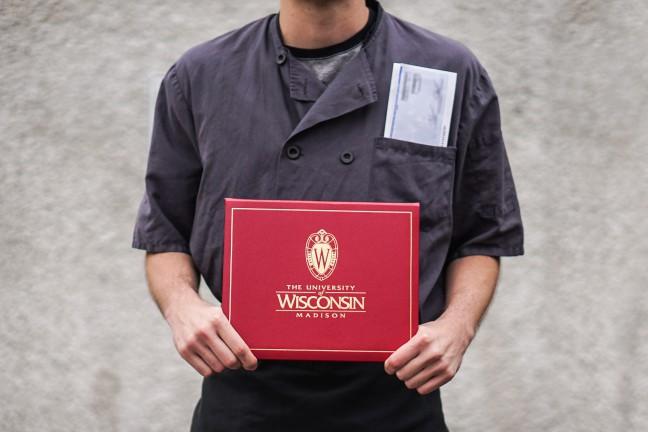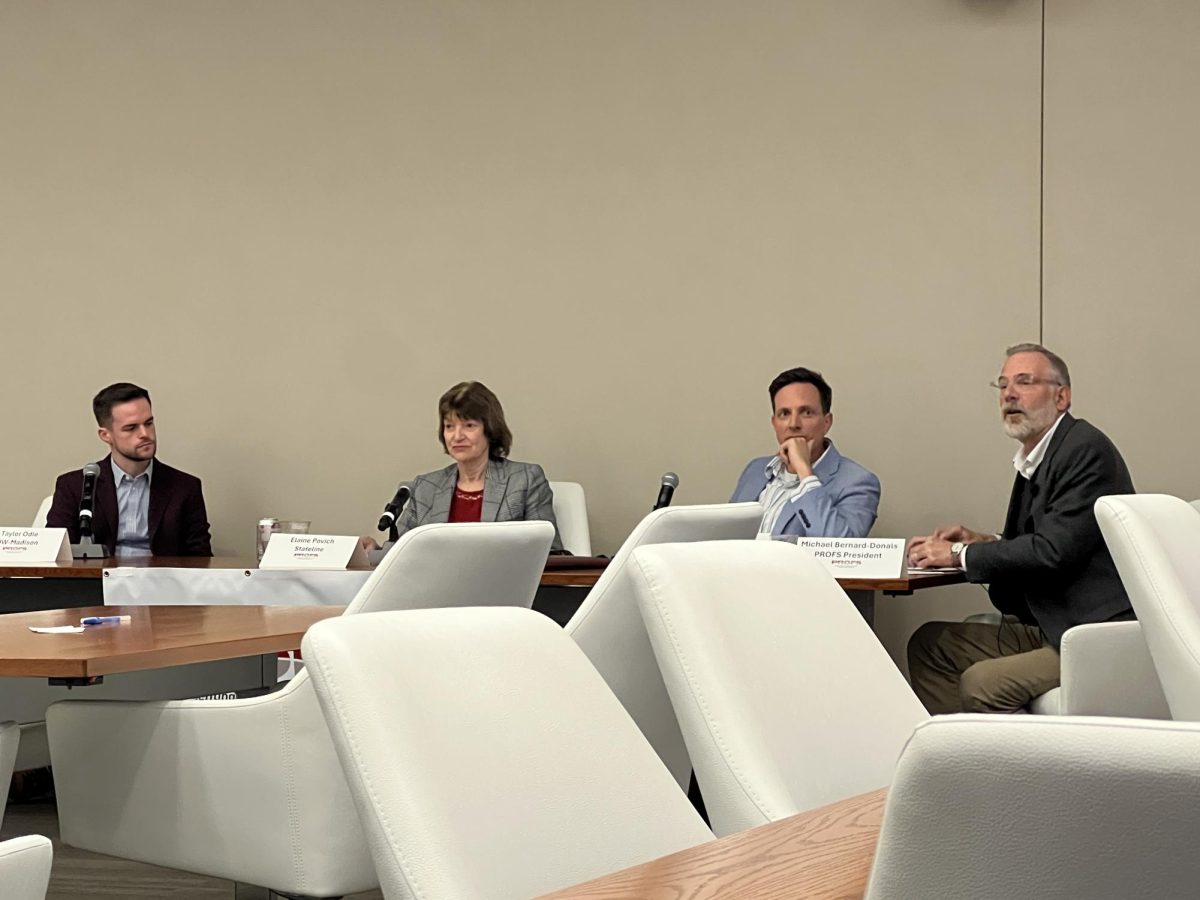Danny Levandoski, a political science and history junior at University of Wisconsin, recalled a time when he struggled to make ends meet.
As a sophomore, he worked at Gordon Dining and Event Center, where he made $9.55 an hour as a student supervisor. Even so, he could barely afford to scrape together enough funds to live on the campus where he studied.
“That semester there were a lot of months where I didn’t know if I would be able to afford rent … or electricity for my apartment,” Levandoski said. “There were a lot of nights where I just didn’t know what to do. I can only work so much.”
To begin to address cases like Levandoski’s, UW administration announced in February that it would set the campus minimum wage to $9 an hour for its more than 14,000 campus workers, starting Sept. 1, 2016.
But for Levandoski and other student workers, a $9 minimum wage is not enough. Levandoski is a member of the pro-labor student group, Student Labor Action Coalition and is pushing for a $15 minimum wage for all UW student workers.
“We’re being given peanuts for wages,” Levandoski said. “This is more than offsetting the cost of going to school. It’s about surviving.”
But the university cannot afford to raise the minimum wage past $9 an hour, especially as UW faces an $86 million slash to its budget, UW spokesperson John Lucas said in an email to The Badger Herald.
“We believe the steps we have taken to date are reasonable in the context of our overall financial situation and there has not been a change in our approach toward the issue,” Lucas said.
“We’re being given peanuts for wages. This is more than offsetting the cost of going to school. It’s about surviving.”
ASM kept in the dark
Associated Students of Madison Chair of the 22nd session Madison Laning said she realizes the importance of campus jobs for students who rely on that income to survive.
“They wouldn’t be able to be here without this money,” Laning said. “I think that student workers should be students first, but with the current cost of living and fees, it’s impossible … on this campus. That’s just a sad reality that administration needs to wrap their head around.”
Laning said she supports the $9 minimum wage and is interested in seeing the wage further increase, but said university administration, both before and after the February wage announcement, has not provided student government with a platform to begin addressing the issue.
Laning said she and a few other ASM members had met with administration in fall 2015 to discuss student wages, but because they lacked in-depth knowledge of UW’s financial situation, ASM was unsure of an appropriate student wage to lobby for.
This is why Laning sought to introduce a shared governance committee in spring 2016, The Student Workers Committee, to address issues facing student workers.
“There were small conversations [on wages], but without that specific shared governance group or access to information, we were having conversations on a surface level,” Laning said.
In a February email correspondence between Laning and Chancellor Rebecca Blank that was provided to The Badger Herald, Laning wrote that many students are working more than allowed, not getting paid enough, not given a paid break and not treated with respect. She also noted UW has some of the highest student employee turnover rates, and there must be a reason for it.
Laning wanted the shared governance committee to act as a hub for addressing those issues, she said.
But in the correspondence, Blank denied the request, saying that “standing committees always create their own work, and there’s not foreseeable work on this front.” Blank said the university’s current budget situation will not support greater wage increases in the near future, and does not want to create a standing committee to focus on something that cannot be supported budgetarily at the moment.
Instead, Blank offered to support an ad hoc committee on the issue that would be dissolved by the end of the spring 2016 semester. Laning turned down the offer, saying any decisions made in this committee would be irrelevant by the fall due to UW’s changing budget situation.
Laning said former Vice Provost of Finance and Administration Darrell Bazzell was an ally in helping ASM create the standing committee on student wages, and added that his departure in March decreased the likelihood of moving to a higher wage anytime soon. She remains hopeful, however, that progress will eventually be made.
“We’re trying to find who will be our next best ally in administration,” Laning said. “We’re still pushing for that committee. That was something that Bazzell was really passionate about, but he’s obviously left us now, so we’re trying to push forward somehow with a shared governance committee that can review these budgets and start those conversations, because that wasn’t happening this year.”
Administration’s response
In the emails, Blank admitted “the cost of going from $7.50 to $9.00 minimum is much less than the cost of going from $9 to $10 because you affect so many more units and so many more students.”
The average hourly wage for UW’s more than 14,000 student employees is already more than $10 an hour, UW spokesperson Meredith McGlone said in an email to The Badger Herald.
According to the Wisconsin State Journal, 44 students made $7.25 an hour as of October 2015, and 2,571 were paid less than $9 an hour.
McGlone said the increase in the campus minimum wage from $7.25 to $9 an hour affected 4,300 students, at a cost of about $500,000. McGlone added that increasing the minimum wage to $15 an hour would cost the university more than $19 million, something that “would undoubtedly result in fewer student positions, higher student segregated fees and less service for students.”

UW human resources has already cut 6,500 student employment hours due to budget cuts from the 2015-17 biennial budget. Student employment is meant to help defray college expenses, not to be the primary funding source for a college education, McGlone said.
But Luke Gangler, a SLAC member, said Blank and university administration are simply not prioritizing student workers. He said the university needs them, and thus can afford to implement a living wage.
As an example, Associate Director of Dining and Culinary Services Julie Luke said the Division of University Housing could potentially use funds currently allocated for housing renovations, and reassign them to pay for increases in student wages. Many of the renovations are mechanical improvements, however, which Luke said are likely a priority for student employees.

Continuous setbacks
Levandoski cited an introduced change to dining and housing student employee wages that to SLAC, represents another setback for student employees.
Next year, student housing and dining will implement a new three-tier system to determine employee wages, Luke said.
Housing’s old system for wages provided a $0.75 raise for student workers who returned for another year. Luke said the new tiered system will require students to work 250 hours for their first raise of $0.25. To receive a second raise of $0.50, student employees will be evaluated on their skills, knowledge and performance.
The move, which was planned before the university’s wage announcement, was calculated to save housing around $79,000 per year, Luke said. But after the minimum wage hike, she said the planned savings will be less.
Luke said the plan was not formulated with the intent of saving money, but rather to better engage student employees. But Levandoski claimed the second evaluation-based raise creates a system unfair for students.
“It’s creating a meritocracy,” Levandoski said. “The second raise is creating a system where those who look more favorable in the eyes of supervisors will be considered for raises. It’s less money over a longer period of time.”
Fighting for $15
Levandoski and Gangler are helping spearhead the campus movement for a $15 minimum wage.
Gangler said SLAC has been focusing on student wages for about a year. After seeing various universities around the country heed to student demands for a $15 minimum wage, he said UW is far from pioneering the issue.
University of California, University of Washington, New York University and Columbia are all implementing $15 minimum wages.
“From our point of view, UW is not blazing the trail, [and] is really resisting not only wage issues, but also important workplace safety and anti-discrimination issues as well,” Gangler said.
Gangler appreciates the university’s response to growing pressure on the issue, but said UW should not take credit for barely raising the bar. The current wage for the 1,819 students who work in UW Housing, for instance, is $8.80 an hour.
“A 20 cent raise should not be celebrated,” Gangler said.


















